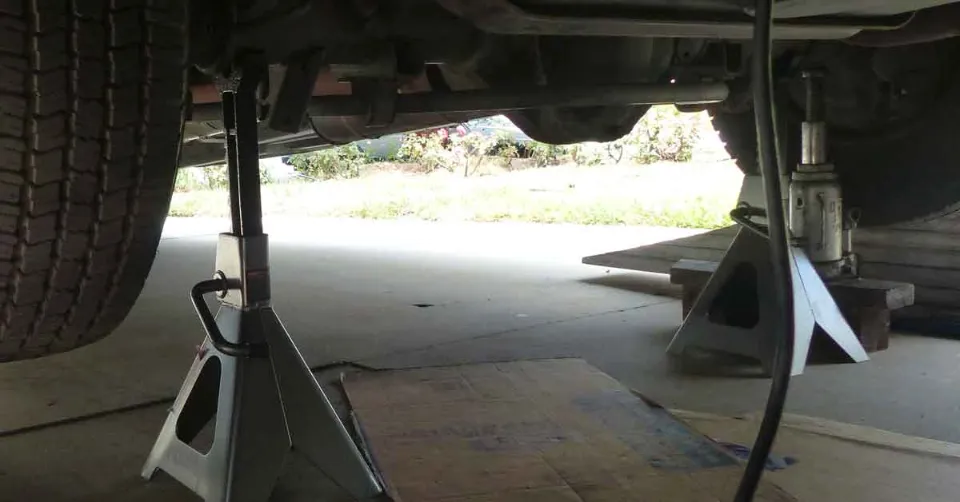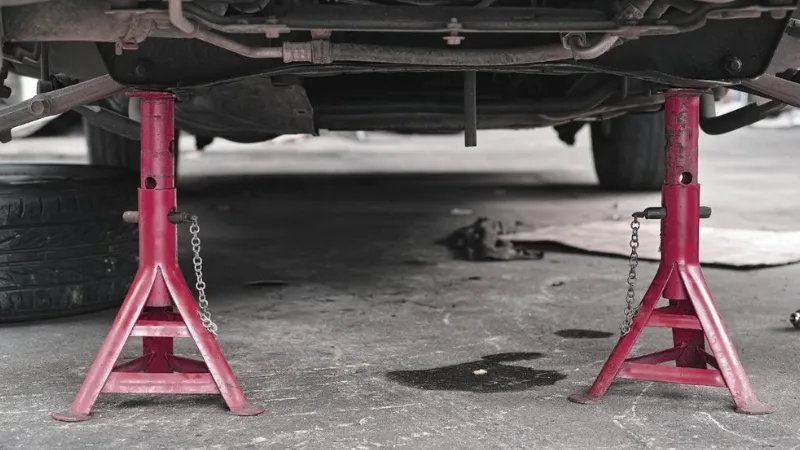While a tire can be changed with just a car jack, any other work that needs to be done underneath your car should be done so using jack stands. Below will give you tips on how to use jack stands safely.
Jack stands must be placed directly under the lifting point. There should be enough room at every jack point to accommodate the stand’s grip. A properly rated jack stand will support the weight of the car when the floor jack releases its hydraulic pressure as long as the stand is flat.
Please continue reading for more information.
What is a Jack Stand?
A jack stand is a mechanical device made of metal with a height adjustment that supports the weight of a lifted vehicle. They’re typically positioned underneath the car as a safety net to guard against a part of the body being struck by a falling object.
How to Use Jack Stands Safely?
Below are the steps on how to use jack stands safely:
Phone a Friend
While it’s not necessary, we strongly advise doing auto work with a partner whenever possible. It always helps to have an extra set of eyes or hands, even if it’s just your son/daughter or a friend with little automotive experience. Even better, they might notice something you didn’t! Have them hand you tools if nothing else. If you have those nifty color-coded tools, it’ll help the uninitiated to quickly find exactly what you need!
Find a Level Surface
Use a floor jack and flat-surfaced stands at all times. If there’s more than a slight, barely noticeable slope, one half of the vehicle could roll or shift out of place when the tires lift off the ground. Put the car in park if the transmission is automatic. If it’s a manual transmission, put it in first gear. Pull the parking brake in both situations to keep your car stationary at all times.

Place Wheel Chocks
In the event that one end of your vehicle rolls backwards or forwards, wheel chocks are your last line of defense. Even a slight roll could cause your vehicle’s undercarriage to move off the floor jack or jack stand, which could have dire, potentially fatal, consequences. So, let’s make an effort to prevent that.
Set Floor Jack at OEM Jacking Points and Lift Vehicle
There is still one more step to complete before lifting your car and using jack stands safely. Steps 1 through 3 were all about safety. To find the proper jacking points for your car, consult the owner’s manual, then lift from those points and those points only. The floor jack you employ needs to be high-quality, manufactured by a reputable company, and properly rated for the weight of the vehicle. When jacking up the vehicle, cover as much of the jack point’s center as possible, but leave enough room for the jack stand.
Move Front to Back (or Back to Front)
Finish the front or back half of the vehicle if you intend to lift all four wheels. You don’t need to be concerned about wheel chocks once half of your car is in the air. For the remaining wheels, just carry out steps 4 and 5.
Stability Check
Give your car a few light shoves to verify that the stands are all in place. Ensure the vehicle is level, with all stands are raised to the same height. Your car should be secure to leave on stands for as long as necessary under normal circumstances if everything checks out. You can now start working, which is wonderful.
Raise and Lower
The last thing you’re going to do, of course, is lower the vehicle. Roll the floor jack under a jacking point, lift the car just above the stand, and then take the stand off. Lower the vehicle as slowly as you can. Even though the descent seems quick, it will be easily absorbed by the shocks. Remember to install wheel chocks at both sides of the tires once half the car has been lowered, just as you did when raising the car. If you’re really being cautious, you can even do this as soon as the first tire lands. Give yourself a well-deserved pat on the back after going through these steps for each OEM lift point. You’re an expert at lifting vehicles now.
Place Your Jack Stand
In front of the lifting point, jack stands must be positioned. At each jack point, there should be enough space for the stand’s grip. When releasing hydraulic pressure from the floor jack, a properly rated jack stand will hold the weight of the car as long as the stand is flat. Any tilting of the jack or uneven weight distribution of the vehicle on top of the stand will cause issues. Check that the car is firmly pressed against the stand before lowering the hydraulic jack all the way. The stand shouldn’t move at all.

Warnings
- Always use jack stands when working underneath your car. The vehicle might fall on top of you if car jacks fail.
- To prevent your vehicle from rolling away when you begin jacking it, make sure your parking brake is engaged and your wheels are chocked.
- The information in this article is intended to provide general answers for frequently asked questions about this topic, and may not be applicable to all vehicles. For information on maintenance schedules and other vehicle specifications, please consult your vehicle’s owner’s manual. We advise getting in touch with a licensed automotive technician to handle the necessary work if you are unsure of your ability to handle any repairs.
Read about How to Use a Car Jack
Anatomy of a Jack Stand
These fundamental components allow most jack stands to work.
- Base
With a four-legged base frame, the jack stand is typically anchored to the ground. It has a pyramidal shape, or four As connected at the sides. Through a central opening in the base, the support bar can be raised and lowered. A different design uses a flat platform with a tube at the center.
- Support Bar
The point of contact between the stand and the car is the support bar. This bar typically has a U-shaped catch at the top and is ratcheted so that when it is raised, it remains in place at the desired height.
- Locking Pin/Mechanism
The majority of jack stands include their own failsafe/backup plans in addition to the ratcheting mechanism that holds the support bar in place. Most frequently, this takes the form of a pin of some kind that is inserted through the support bar or is set up against the ratchet teeth of the bar.
- Release
Most frequently, the release is a handle that deactivates the support bar’s ratcheting mechanism so that it can be lowered.

Common Types of Jack Stands
Different jack stands use different locking mechanisms. These are the most common types.
- Ratchet
As mentioned above, ratcheting is one of the most commonly used types of jack stands. A ratcheting device is built into the support bar, so it automatically locks into place when lifted. The handle is typically used to release it.
- Pin
Many ratcheting jack stands use pins to increase security, but some only use pins. To change the height on these stands, insert the pin through one of the numerous holes that are available.
- Screw
A screw-type jack stand is less common, but they do exist. These stands have a massive screw in the center of an upright cylinder that serves as the support beam. Screwing the beam in or out changes the height of the jack stand’s catch.

FAQs
Where Do You Place Jack Stands on a Car?
Four jacking points are present on the majority of vehicles. They’re located under the car’s rocker panels, just behind the front wheels and just ahead of the rear wheels.
Are Jack Stands Safer Than a Jack?
Jack stands cannot raise automobiles. Instead, they provide a safe, fixed support for a raised vehicle. Every time you lift a vehicle, use a pair of jack stands to greatly reduce your risk of getting hurt by a falling vehicle.
Do You Need 1 Or 2 Jack Stands?
If lifting just one end of your car, you’ll need two jack stands. Utilize four jack stands when lifting the entire vehicle. Thick plywood can keep them from sinking when placed on soft ground like asphalt or grass.
Do Jack Stands Go under Axle Or Frame?
The most reliable and secure way to raise a car is with jack stands. Always be sure to place jack stands under the control arms, frame crossmember or frame members. The rear axle is frequently the recommended location for jack stands if all four wheels need to be lifted off the ground for exhaust or transmission work.
Summary: How to Use Jack Stands?
When using jack stands, make sure to place them at your vehicle’s pinch points or on its frame to keep them from slipping. Lift your car up after finishing your work and remove the stands from the bottom, and you’re ready to go!
If you have any questions, please leave a comment. KV Auto tries to give you the best car industry information. Thank you for reading.





